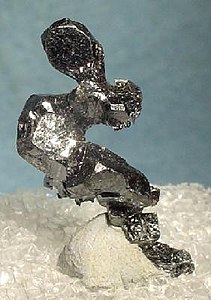Acanthite
| Acanthite | |
|---|---|
 Crystallized acanthite (4.0 × 2.5 × 1.5 cm) from Imiter mine, Jbel Saghro mountain range, Morocco | |
| General | |
| Category | Sulfide mineral |
| Formula (repeating unit) | Ag2S |
| IMA symbol | Aca[1] |
| Strunz classification | 2.BA.30a |
| Crystal system | Monoclinic[2] |
| Crystal class | Prismatic (2/m) (same H-M symbol) |
| Space group | P21/n |
| Unit cell | a = 4.229 Å, b = 6.931 Å c = 7.862 Å; β = 99.61°; Z = 4 |
| Identification | |
| Color | Iron-black |
| Crystal habit | Primary crystals rare, prismatic to long prismatic, elongated along [001], may be tubular; massive. Commonly paramorphic after the cubic high-temperature phase ("argentite"), of original cubic or octahedral habit |
| Twinning | Polysynthetic on {111}, may be very complex due to inversion; contact on {101} |
| Cleavage | Indistinct |
| Fracture | Uneven |
| Tenacity | Sectile |
| Mohs scale hardness | 2.0–2.5 |
| Luster | Metallic |
| Streak | Black |
| Diaphaneity | Opaque |
| Specific gravity | 7.20–7.22 |
| References | [3][4][5][6] |
Acanthite is a form of silver sulfide with the chemical formula Ag2S. It crystallizes in the monoclinic system and is the stable form of silver sulfide below 173 °C (343 °F). Argentite is the stable form above that temperature. As argentite cools below that temperature its cubic form is distorted to the monoclinic form of acanthite. Below 173 °C acanthite forms directly.[3][6] Acanthite is the only stable form in normal air temperature.
Occurrence
[edit]Acanthite is a common silver mineral in moderately low-temperature hydrothermal veins and in zones of supergene enrichment. It occurs in association with native silver, pyrargyrite, proustite, polybasite, stephanite, aguilarite, galena, chalcopyrite, sphalerite, calcite and quartz.[3]
Acanthite was first described in 1855 for an occurrence in the Jáchymov (Joachimsthal) district, Ore Mountains, Bohemia (today Karlovy Vary Region, Czech Republic). The name is from the Greek "akantha" meaning thorn or arrow, in reference to its crystal shape.[4][5][6]
Gallery
[edit]-
Classic acanthite specimen from the Rayas Mine at Guanajuato, Mexico. Size: 2.4 × 1.1 × 1.1 cm.
See also
[edit]References
[edit]- ^ Warr, L.N. (2021). "IMA–CNMNC approved mineral symbols". Mineralogical Magazine. 85 (3): 291–320. Bibcode:2021MinM...85..291W. doi:10.1180/mgm.2021.43. S2CID 235729616.
- ^ Bonewitz, Ronald Louis (2012). Rocks and Minerals. Dorling Kindersley Limited. ISBN 978-0-7566-9042-7.
- ^ a b c Anthony, John W.; Bideaux, Richard A.; Bladh, Kenneth W.; Nichols, Monte C. (eds.). "Acanthite" (PDF). Handbook of Mineralogy. Chantilly, VA: Mineralogical Society of America.
- ^ a b Mindat.org
- ^ a b Webmineral data
- ^ a b c Klein, Cornelis and Cornelius S. Hurlbut, Manual of Mineralogy, Wiley, 20th ed., 1985, pp. 271-2 ISBN 0-471-80580-7

